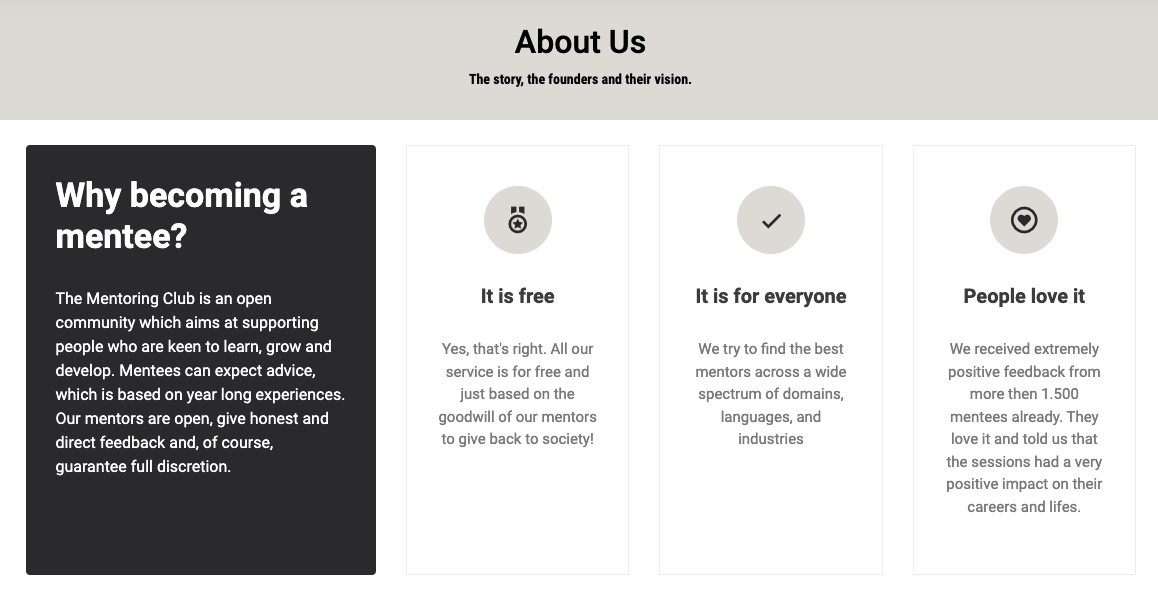
The average salary for a Web Developer can vary widely depending on experience, location, skills, and the type of job performed. The Gross Income (base salary), minus any additional compensation such as tips, commissions, profit sharing and overtime, is the basis of Salary Information. The Total Pay takes all these factors into consideration. Because salaries can vary widely, these numbers should be used only as a guide and may not reflect all industries and locations.
Developers of web sites have good job prospects
According to U.S. Bureau of Labor Statistics Web Developers are in strong demand. This occupation will continue to see growth. There will be 13 percent more job openings between now and 2026 than in the average of all occupations. Increased use of mobile devices as well as internet-connected computers is driving the increase in demand. Furthermore, the BLS projects that 17,900 new jobs will be created each year.
Websites are becoming increasingly global. Web developers need to be familiar with the cultures and languages of other countries. Web development is a global career. While some jobs can be transferred to lower-wage countries, managing web developers in different time zones may offset any savings businesses make. Web developers with knowledge of several programming languages and digital multimedia tools will have the best opportunities. Web developers generally have good prospects, but the most desired skill will be the ability of users to communicate in many languages.

Skills required for the job
One of the most important skills for a web developer is good communication. Without sounding condescending, you should be able communicate complex ideas without sounding arrogant. Web development benefits should be clearly explained to clients. Web developers need to be creative but also be able and willing to work as part of a team. A web developer must have technical skills but also be able listen to and communicate effectively.
Front-end developers should be proficient in HTML, CSS, JavaScript. These languages are vital for creating websites. They can be used to teach computers how to display information, retrieve information, and respond with user input. The web is made up of a series of interlocking instructions. This is the base of your visual experience. The knowledge of database security, cybersecurity, and security is essential for front-end development. They are the ones that create and maintain websites.
Cost of living
If you're planning on making a career move in web development, it's crucial to know the cost of living in the city you're considering. Cost of living is variable from city to city so make sure to add this to your calculations. SalaryExpert's PhD-level research team compiled the cost per capita for major cities all over the globe. These are the average salaries for different cities:
You may have to adjust your salary depending on where and how much you live. New York City has a significantly higher cost of living than Oklahoma. Therefore, companies looking for developers in New York City need to offer more competitive salaries. Although these differences may not seem significant, they can make a big difference in the quality of life for web developers. It is crucial to consider both these factors when you negotiate your starting salary.

Hourly rate
The average salary for web developers varies from one city or another, but there are certain generalities that can apply across the board. These numbers were compiled from data provided by Indeed, Glassdoor and CWJobs. The New York City salary for web developers is significantly higher than the Oklahoma City one. Additionally, the rates in European cities are different. These salary figures can help you negotiate for a better salary, whether you want a starting or an increase.
The hourly rate for web developers varies according to experience and level of expertise. An hourly average wage for a web developer working full-time is $68. A freelance web developer can choose to work remotely at a $28 hourly rate if they want more autonomy. An hourly wage for a part-time developer is between $25-43.
FAQ
Which website builder should I use?
The best way to build an effective web presence is to start small. If you have the time and resources to build a full-blown site, then do so. A simple blog is a good option if you don’t yet have the necessary resources. As you become proficient in web design and development, you can add features as needed.
However, before you create your first website you need to set up a primary URL. This will provide you with a point of reference when you publish content.
Can I create my own website with HTML & CSS?
Yes! If you've followed the steps, you should now be able create your website.
You now know how to build a website structure. Now you need to learn HTML and CSS coding.
HTML stands for HyperText Markup Language. This is like writing a recipe. You'd list the ingredients, instructions, along with directions. HTML allows you to indicate to a computer which portions of text are bold, italicized and underlined. It also lets you know which part of the document is linked. It is the language of documents.
CSS stands for Cascading Style sheets. It is like a stylesheet that you use to create recipes. Instead of listing out each ingredient and instruction, you write down general rules for things like font sizes, colors, spacing, and more.
HTML tells the browser how a page should look; CSS tells it what to do.
You don't have to be a prodigy if you don’t get the terms. Follow the tutorials and you will soon be creating beautiful websites.
How to design a site?
Your customers will first need to understand the purpose of your website. What are they looking for when they visit your site?
What problem might they face if your site doesn't have what they are looking for?
You now need to know how to fix the problems. It is also important to ensure your site looks great. It should be easy to navigate.
You should have a well-designed website. It shouldn't take too much time for it to load. If it does take too long, people won't stay as long as they would like to. They'll go somewhere else instead.
It is essential to determine where all your products reside before you start building an eCommerce website. Do they all reside in one spot? Are they all in one place?
It's important to decide if you want to sell just one product or multiple products. Are you interested in selling one type of product? Or multiple types?
Once you have answered these questions, you can begin building your site.
Now you need to worry about the technical side of things. How will your site work? Is your site fast enough to be useful? Is it possible to access the information quickly using a computer?
Will people be able to buy something without having to pay extra? Will they have to register with your company before they can buy something?
These are the essential questions you should ask yourself. When you have the answers, you can move on.
How to Make a Static Site
To create your first static website, you'll need to choose between two options:
-
Using a Content Management System (a.k.a. WordPress: This software can be downloaded and installed on your computer. You can then use it to build an important website.
-
You will need to create a static HTML website. It's not hard to do if you already understand HTML.
It is worth hiring an expert if you want to build large websites.
You should start with option 2.
What is the cost of creating an ecommerce website?
This depends on your platform and whether you hire a freelancer or go through a service provider. Most eCommerce sites start at around $1,000.
Once you have chosen a platform, expect to pay between $500 and $10,000.
You won't spend more than $5,000 if you are using a template. This includes any customization you need to make to fit your brand.
WordPress is it a CMS?
The answer is yes. It's a Content Management System (CMS). Instead of using Dreamweaver or Frontpage, a CMS lets you manage your website content directly from your web browser.
The best part about WordPress is that it's free! Other than hosting, which you usually get from your ISP.
WordPress was initially intended to be used as a blog platform. Now, WordPress offers many different options: eCommerce sites, forums. Membership websites. Portfolios.
WordPress is simple to install and configure. To install WordPress, you will need to download the installer file from their website. Once it is downloaded, upload it to your server. Next, simply go to your domain name via your web browser and log into your new site.
After installing WordPress you will need to create a username/password. Once you've logged in, you'll see a dashboard where you can access all of your settings.
You can now add pages, posts and images to your site. This step may be skipped if you feel confident editing and creating content.
If you prefer to work with a professional web designer, you can hire them to manage the entire process.
What is website design software?
Website design software is used by graphic artists, photographers, illustrators, writers, and others involved in visual media to create webpages and other digital materials.
There are two types main website design software options: desktop apps and cloud-based. Desktop apps can only be installed locally on your PC and will require additional software to run on your system. Cloud-based solutions are hosted remotely on the internet and require no additional software on your computer, making them ideal for mobile users.
Desktop Applications
Desktop applications may have more advanced features than cloud-based solutions but they aren’t always necessary. Some people prefer working exclusively on a desktop app, as they find it easier. Others like to use the same tool regardless of whether they are working on a laptop or a smartphone.
Cloud-Based Solutions
A cloud-based solution is a good choice for web designers who are looking to save money and time. These services make it possible to edit any type document from anywhere with an Internet connection. This means you can use your tablet to do some work while you wait for your cup of coffee to brew.
If you decide to use a cloud service, you will still need a license. You don't have to buy additional licenses for upgrading to the latest version.
These programs can be used to create web pages, if you have Photoshop, InDesign or Illustrator.
Statistics
- In fact, according to Color Matters, a signature color can boost brand recognition by 80%. There's a lot of psychology behind people's perception of color, so it's important to understand how it's used with your industry. (websitebuilderexpert.com)
- Is your web design optimized for mobile? Over 50% of internet users browse websites using a mobile device. (wix.com)
- Studies show that 77% of satisfied customers will recommend your business or service to a friend after having a positive experience. (wix.com)
- It's estimated that in 2022, over 2.14 billion people will purchase goods and services online. (wix.com)
- Did you know videos can boost organic search traffic to your website by 157%? (wix.com)
External Links
How To
What is website hosting?
Website hosting is the place where visitors go to visit a website. There are 2 types.
-
Shared hosting – This is the most affordable option. Your website files are stored on a server that is owned by another person. Customers visiting your website send their queries over the Internet, to that server. The request is sent to the server's owner who then passes it on to you.
-
Dedicated hosting: This is the most costly option. Your website resides entirely on one server. There are no other websites sharing space on the server. Your traffic remains private.
Most businesses choose shared hosting because it's less expensive than dedicated hosting. Shared hosting allows you to have your website run by the company who owns the server.
However, both have their advantages and disadvantages. These are the key differences between them.
Shared Hosting Pros:
-
Lower Cost
-
Easy to Set Up
-
Frequent updates
-
It can be found on many web hosting companies
Hosting shared can be as low as $10 per month. Remember that shared hosting usually comes with bandwidth. Bandwidth describes the amount of data that can be transferred over the Internet. Even if only you upload photos to your blog or website, high-volume data transfers may incur additional charges.
Once you begin, you will soon see why you spent so much on your previous host. Many shared hosts offer very little customer support. Their techs will occasionally walk you through setting up your site, but you're on your own after that.
You'll want to look into a provider that offers 24-hour phone support. They'll take care of any issues that come up while you sleep.
Dedicated Hosting Cons:
-
More Expensive
-
Less common
-
Requires specific skills
With dedicated hosting, you get everything you need to run your website. You won't have to worry about whether you're using enough bandwidth or whether you've got enough RAM (random access memory).
This means that you will have to pay a little more upfront. However, once your business goes online, you'll discover that you don’t need as much technical support. You'll be able to manage your servers effectively.
Which Is Better For My Business:
This depends on the kind of website that you want. If you're selling products only, shared hosting might work best. It is easy to set-up and manage. Because you share a server, you will most likely receive frequent updates.
However, dedicated hosting can be a great option if you're looking to build a community around the brand. Instead of worrying about traffic, you can concentrate on building your brand.
Bluehost.com is a web host that offers both. Bluehost.com provides unlimited monthly data transfer, 24/7 support, free domain registration and a 30-day money back guarantee.